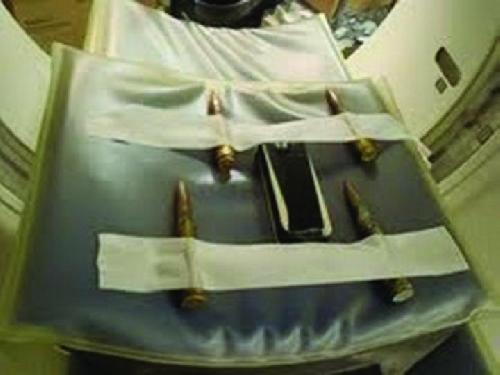CHARLOTTESVILLE, VA (FEBRUARY 2, 2016). In the paper "Stratification of risk to the surgical team in removal of small arms ammunition implanted in the craniofacial region: case report, by Jonathan A. Forbes, MD, and colleagues (published today in the Journal of Neurosurgery; http://thejns.org/doi/full/10.3171/2015.6.JNS15779), the authors discuss risk assessments that are necessary when a surgical team is required to remove embedded ordnance that may contain explosive materials.
Neurosurgery often poses danger, but generally it is the patient alone who faces the danger. In this article, the authors describe a case in which ammunition was embedded in the base of a patient's skull. The setting was Operation Enduring Freedom in Afghanistan.
The authors recount how they planned and conducted surgery in a young, pregnant Afghan woman, who was hit by a projectile that had ricocheted off a nearby hard surface, entered her left cheek, and became lodged in her skull base. At the time of presentation the precise nature of the projectile was unclear, and the surgical team had to approach the patient as though unexploded ordnance (UXO) was involved.
 This is a photograph of four projectiles prior to CT scanning (left to right): armor-piercing tracer, full metal jacket, armor-piercing high explosive, and armor- piercing. A block of C4 is in the center. Credit: Copyright 2016 AANS.
This is a photograph of four projectiles prior to CT scanning (left to right): armor-piercing tracer, full metal jacket, armor-piercing high explosive, and armor- piercing. A block of C4 is in the center. Credit: Copyright 2016 AANS.
The authors use this case to illustrate the protocol that surgeons should follow when a patient may harbor an explosive projectile. Citing a paucity of literature on identification of small arms ammunition with explosive potential, the authors discuss clinical and radiological risk factors that should be considered to optimize the well-being of patients and the surgical team.
The article states that UXOs are not uncommon in a wartime setting and have been identified in some assassination attempts. The authors tell us that UXOs are far less likely to be present in other instances, perhaps because this explosive ammunition is far more expensive than non-explosive ammunition.
Radiological studies offer valuable information for determining whether embedded projectiles are likely to be UXOs. The paper furnishes radiographs and CT scans demonstrating a variety of projectiles. Accompanying the images are detailed descriptions of incendiary and explosive projectiles and how each item can be identified on imaging studies. The authors state that radiological risk factors for the presence of a UXO include a projectile whose caliber is larger than 7.62 millimeters, alterations in the projectile's tip, and the presence of a hollowed-out core in the projectile's base. The authors assure the reader that, in the event a UXO is present, diagnostic radiography and ultrasonography are deemed safe and CT scanning is believed to carry minimal risk.
Should the presence of a UXO be confirmed prior to surgery, the authors offer detailed guidelines on how to conduct surgery for projectile removal. In brief, the operation should take place in an ancillary area, away from other procedures. Surgical garb should be donned after battle-protective equipment. The surgical team should be limited in number, and the anesthetist should leave the area during UXO removal. Electrocautery should be avoided and flammable materials (such as supplemental oxygen) should be kept at a minimum. If the patient has more than one wound that requires surgical repair, the wound housing the UXO is the first priority. Obviously, the greatest care should be taken to gently remove the projectile.
The authors also include advice on transporting the patient to the hospital and caring for the patient before surgery while minimizing risks to all involved.
Throughout the paper, the authors stress the inclusion of expert opinion from a nearby explosive ordnance disposal (EOD) unit in any assessment of whether an embedded projectile is a UXO, as well as adherence to clinical practice guidelines established by the Joint Theater Trauma System.
In summarizing the study findings, Dr. Jonathan Forbes stated, "Infrequently, implanted small arms ammunition can harbor explosive filler material. Preoperative knowledge of this likelihood can help decrease intraoperative risk to the surgical team. Injuries suffered during assassination attempts and/or wartime settings, munition larger than 7.62 mm, and radiological evidence of a hollowed-out core or alteration of density in the projectile tip should raise suspicion of the possibility of explosive potential. This article provides a useful reference for surgeons who are faced with this clinical scenario."
source: Journal of Neurosurgery Publishing Group